Expanding Literacy
As reading and writing skills develop, students spend more time reading on their own for education and pleasure. Reading provides a way to gather information and to learn about the thoughts, opinions, and feelings of others. Writing allows students to show what they know and feel, and to be creative. Reading and writing are the foundation of learning, and being able to read and write are skills that help students prepare for employment and adulthood. Becoming an independent reader and developing the ability to express oneself in writing are critical to success in today's society.
It is essential that students with combined vision and hearing loss receive the tools and opportunities they need to maintain and expand their individual literacy skills. This holds true regardless of where a child or young adult falls on the literacy development continuum and calls for appropriate accommodations and supports to remain in place throughout and beyond the school years.
Literacy is not a luxury, it is a right and a responsibility. If our world is to meet the challenges of the twenty first century we must harness the energy and creativity of all our citizens. (Bill Clinton, 1994)
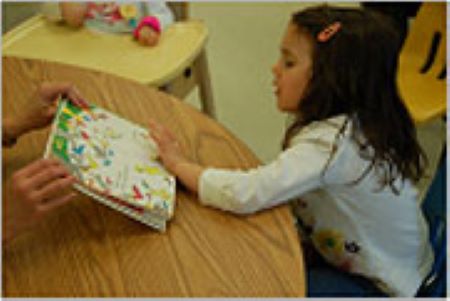
Reading materials must be provided in whatever format(s) a student needs to allow access to the same content available to students without sensory losses. This may include large print, braille, audio readers, educational interpreters, picture representations, assistive technology devices, or a combination of these. When additional physical challenges are present, writing instruments need to be adapted or assistive technology devices provided. Evaluating a child's comprehension of what he or she is reading frequently and in a consistent manner is important and should be incorporated into instructional planning. It is also essential that teachers, parents, and caregivers have high expectations for students and provide learning environments, instructional strategies, and accommodations that acknowledge and honor each student's strengths and needs.
Related Skills
Literacy skills should not be taught in isolation because they relate to numerous developmental and academic standards often being addressed by a child's educational team. Awareness of interrelated skills assists teams in IEP development and planning holistic instruction.
Attention and Response
Attention/response to informational cues, literacy partner, stories and word play activities (spoken or signed); increased duration of active engagement with a variety of literary formats across many environments.
Interaction and Communication
Anticipation; joint attention; turn-taking; ability to access literacy partner; increased duration of active engagement with stories, music and/or literacy partner; use of pre-linguistic and/or symbolic forms of communication (touch, object, gestures and/or cues, pictures, print, braille, sign language); response to informational cues; partial/full participation in instructional activities; use of AAC devices for expressive and receptive communication; accessible technology.
Sensory
Use of residual hearing and residual vision to gather information; localization to presented sounds; auditory discrimination; visual fixation; eye gaze; use of tactile, vestibular and proprioceptive activities for enhancing sensory input to increase comprehension.
Tactile/Motor
Exploration of items using touch; imitation of motor tasks; tactile discrimination; eye-hand coordination.
Cognitive
Beginning/middle/end; sequence of events; recall of verbal and non-verbal events; use of symbolic forms (e.g. pictures and/or line drawings, print, braille, sign); generalized understanding of the literacy symbols (text, braille, pictures, symbols) in more than one routine or context; expanding concepts; exploring a variety of literary genres; making connections to text; increasing higher order thinking skills.
Examples
Students with vision and motor skills can make their response by pointing.

Some children will need tactual choices in order to respond.
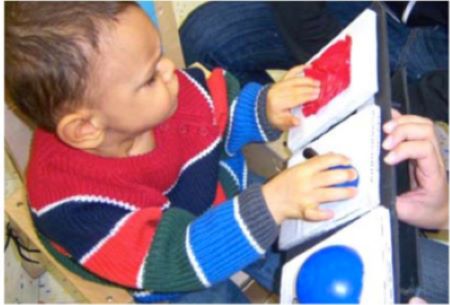
Making Materials Accessible
Examples of how to make materials accessible to deafblind students include the use of:
- Braille
- Large print
- Tape/e-books
- Tactile pictures
- Objects or partial objects
- Signed texts
- Computer texts or tablets
- VOCA or AAC devices
- High lighting/overlay
- Reduce visual complexity
- Use of jigs
- Story boxes
A deafblind student attending the Atlanta Area School for the Deaf had a limited vocabulary in English, but recognized many picture cues and could copy written text. Her teacher developed a picture dictionary for her to help her write sentences in her weekly journal. The dictionary was arranged by categories—food, places, people, things to do, etc.—and had a photograph or Board Maker symbol beside the word typed in 18 point font. The student could find the word she was looking for and write about what happened that week. The teacher and student added new pictures and words to the book each week.
Functional Texts
Opportunities to use literacy skills in the activities of life are important for students with deafblindness because our students have direct experiences with these concepts and activities. Examples of functional texts to get you thinking include:
- Read & follow recipes (start with snack items then move to longer recipes) Seedlings Recipe Book
- Read a bus schedule (use local bus schedules for classroom practice then move to community)
- Read menu (use actual restaurant menus and enlarge or cut apart for accessibility)
- Read calendar (tactile and/or enlarged monthly/yearlong calendars)
- Movie theatre listings
- Coupons & sales
- Follow schedules (tactile, picture, print schedule)
- Newspapers (News2You)
- Read & follow map (tactile maps)
- Read & follow directions
- Medication/prescriptions labels
- Clothing size tags
- Read magazines
- "How to" sources of information
- Newsletters
- Application forms
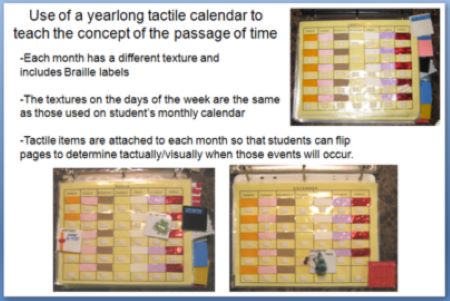
Example of a Read Calendar.
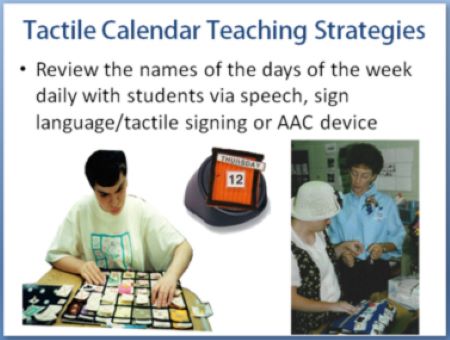
Example of a cognitive skills wheel (below).
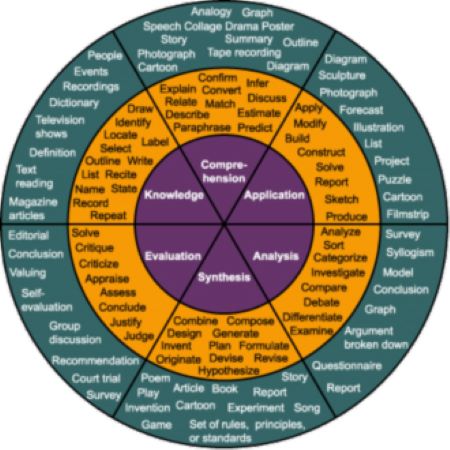
Vocabulary becomes real and remembered when it is paired with experiences children have had hands-on experience with.
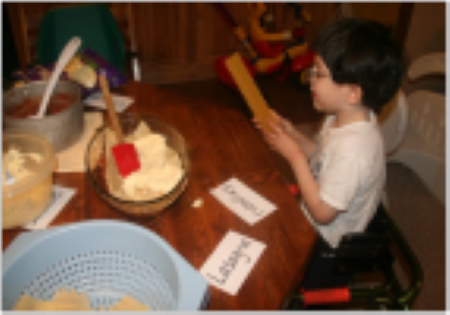
Home and school can provide these experiences. In the picture above, the student's parents used real lasagna ingredients during family dinner preparations to match to vocabulary words.
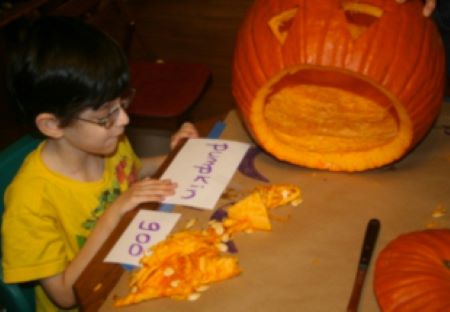
A child who is deafblind gets incomplete and inconsistent information that can lead to delays in concept development and reading comprehension. Words take on richer meaning by adding sensory experiences of touch, smell and taste. The child in the picture above is tasting, smelling, feeling, experiencing his vocabulary words!
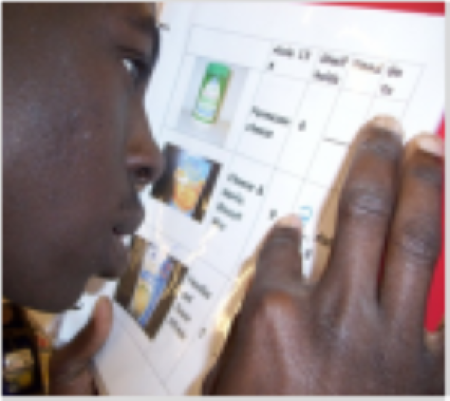
Teachers from the Georgia Academy for the Blind wanted to include literacy skills when students worked stocking extender shelves at the grocery store as part of their community-based vocational instruction. They developed an inventory book that required the students to read the item name, aisle where it is located, number of items that go on a shelf and where the item can be found in the store. The books were individualized for each student's literacy medium (braille, large print, picture cues) and were laminated so the student could write the number needed to restock and erase it to reuse it next week.
Critical Thinking Skills
After reading Brown Bear, Brown Bear What Do You See? by Martin and Carle, students use props, sentence strips and tactile AAC device to author and read their own stories.

Examples of Reading Materials
Literature
The Great Kapok Tree by Lynne Cherry—conservation of rain forest, endangered animals
Stone Fox by John Reynolds Gardiner—kindness, greed, death
Because of Winn Dixie by Kate DiCamillo—friendship, divorce, abandonment, faith, death, alcoholism, prison
Bridge to Terabithia by Katherine Paterson—loneliness, friendship, imagination, death
A Small White Scar by K.A. Nuzum—family member with Down Syndrome, single parent home, frustration, anger, courage
Social Stories
Speaking of Speech is the first and largest interactive forum for speech/language pathologists and teachers to improve communication skills in our schools by exchanging ideas, techniques, materials, and lessons that work, finding out about materials before you buy, seeking and giving advice on therapy and caseload management issues, and exploring a myriad of helpful resource links. Social Skills Printables from My Classroom provides lots of activities to work on social skills.
Newspaper articles
News-2-You is a weekly newspaper for students in special education classes. The standard newspaper is published with four levels of difficulty each week, so there is something to challenge every student—from beginning readers to the high school level.
Readers Theatre
Examples include:
- Helen Keller
- Reader's Theater Scripts (© 2012 Chase J. Young)
Cartoons and Graphic Novels
Make Beliefs Comix is a site that allows you to create your own comics, choosing from a library of images that express different emotions.
Journals
Examples include:
- Diary of Anne Frank
- Martin Luther King, Jr.
Examples of How to Adapt Materials
Adapting materials for readers who are blind, visually impaired, physically impaired, or intellectually disabled can provide them access to the richness of literature, and the independence of reading for information.
To "tactilize" pictures, enlarge a picture so that it can be easily manipulated, print it on cardstock, when possible, and laminate (3 mil sheet lamination is a very strong lamination that accepts Velcro® and tactile items nicely). Velcro the tactile items to the laminated picture/symbol.
Hint: Use soft (female) Velcro® on permanent items such as desks/boards/walls and the rough (male) Velcro® on the backs of pictures/symbols/tactile items. This allows the items to be used throughout your classroom/home, on Veltex or felt boards. As the soft Velcro does not attract fuzz and dirt it also stays cleaner and looks much nicer than using rough Velcro.
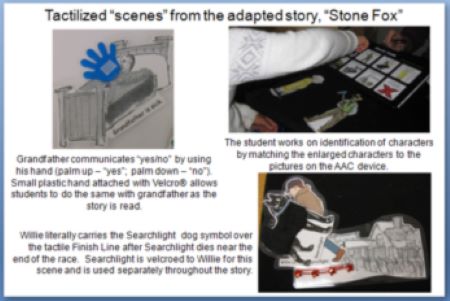
Book Builder can be used to create, share, publish and read digital books that engage and support diverse learners according to their individual needs, interests and skills.
An abstract concept, such as an emotion, may be explained though a series of pictures/tactile symbols. For example when showing how two lonely teenagers become friends, the use of space can show how two persons may be lonely, then move closer and closer to each other until they are side by side—the friendship begins.
(Example below from adapted version of Bridge to Terabithia, adapted by Jessie Moreau.)
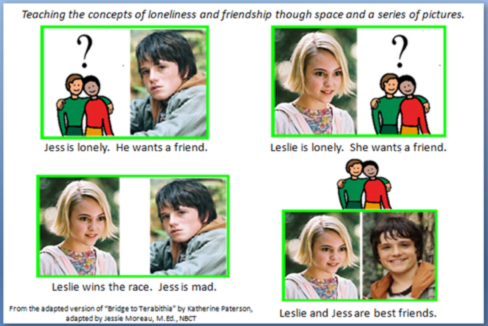
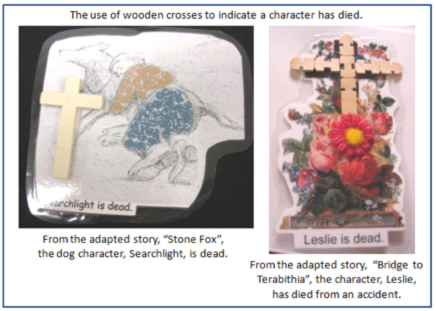
An abstract concept, such as greed, can be illustrated through the use of a greedy cartoon villain, e.g., Snidely Whiplash, and the use of an interactive song.
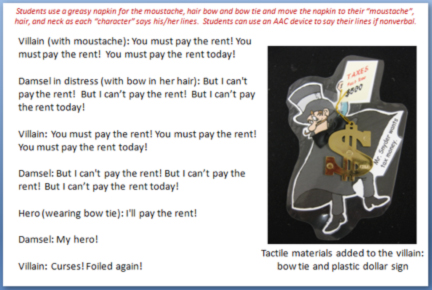
Be sure each student has a way to communicate the concepts of the emotions/attitudes expressively. This can be through pictures and/or AAC devices and overlays. Tactile items should be attached with Velcro® to AAC devices for students who require tactile access.
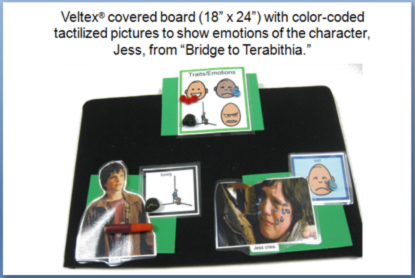
Video Clips
Strategy for updating vocabulary
Updating devices and word books with new words gives students multiple opportunities to practice new words in a variety of contexts. Some great examples of this were found at the Perkins Deafblind Program, where each student had a binder full of their symbols, organized by category, so they could always find symbols they needed.
This video explains technology and accommodations for students with visual loss.
Articles
Assessing Communication and Learning
By Charity Rowland
Literacy for Persons who are Deaf-Blind
This landmark article by Barbara Miles contains a section on the social functions of reading and writing and provides some wonderful ideas for expanding literacy.
Tips for Making Experience Stories
Paths to Literacy has a short article with tips for making experience stories.
Accessing the Curriculum
Martha Majors from the Perkins Deafblind Program has written a good article on accessing the curriculum and making every IEP literacy-based. (page 4)
Issues in Deafblindness: When the IEP Is Aligned with the General Curriculum
This article by Robbie Blaha from the Texas Deafblind Project discusses the challenges deaf-blind students may face when they participate in the general curriculum and what can be done to improve their experience.
Learning Media Assessment
This short document was developed in Texas to help a team make sure the Learning Media Assessment is accurately measuring the effects of combined vision and hearing loss so the team can plan appropriate accommodations for literacy.
Additional Resources
Individualized Instruction
A place for new and experienced special education teachers to learn about strategies, organization ideas and more!
Idaho Training Clearinghouse
This website has webinars and PowerPoint presentations on teaching reading to students with cognitive impairments.
Put Reading First 2006 Guide
Designed by teachers for teachers, this guide summarizes what researchers have discovered about how to successfully teach children to read. It describes the findings of the National Reading Panel Report and provides analysis and discussion in five areas of reading instruction: phonemic awareness, phonics, fluency, vocabulary, and text comprehension. Each section defines the skill, reviews the evidence from research, suggests implications for classroom instruction, describes proven strategies for teaching reading skills, and addresses frequently raised questions.
Paths to Literacy
The Paths to Literacy website, a joint project between Perkins School for the Blind and Texas School for the Blind and Visually Impaired, discusses the special considerations to the Learning Media Assessment when a child has hearing loss. While you're at the site, check out some of the other great resources!
Model Classrooms
This website provides model classrooms for students who are deaf-blind has ideas for working with students with dual sensory loss in the area of literacy.
Adapted Texts
The Paul V. Sherlock Center on Disabilities, founded at Rhode Island College in 1993, is a University Center on Excellence in Developmental Disabilities Education, Research, & Service. The site houses a library of adapted books and lessons available in a variety of formats.
Assorted General Curriculum Projects Adapted Text
Please note: When you do adapt a book, copyright law mandates that to download adapted books, or adapt books not in the public domain, you MUST own a legally purchased copy of the book by the original author.
Using iPads to provide accessible formats for literacy materials
Additional resources for accessible literacy materials include the AppFinder and I-Books such as Pointy Three and Strollin' with Little Baby Owen. The Georgia Tools for Life site has a database of recommended apps by category.
Types of Response Modes
Charity Rowland and Phil Schweigert list types of response modes in Tangible Symbol Systems. The accompanying DVD demonstrates a variety of response modes. Response modes should be easy for the student to make and clear for the adult to understand.
Learning Media Assessment
This short document was developed in Texas to help a team make sure the Learning Media Assessment is accurately measuring the effects of combined hearing loss.
Alternatives to Paper and Pencil Assessments
For students with significant disabilities, alternatives to paper and pencil assessments and answering questions are a must. Diane Browder from the University of North Carolina Charlotte has developed Story-Based Lesson Task Analyses that can help teachers measure responses of their students toward literacy goals. Other good assessments resources include:
- Using Shared Stories and Individual Response Modes to Promote Comprehension and Engagement in Literacy for Students with Multiple, Severe Disabilities
- The State of Louisiana website
- Thoughts on the Assessment of the Student with the Most Profound Disabilities
- Authentic assessment toolbox by Jon Mueller
Enhancing the Literacy Experience for Students who are Deafblind
In this presentation, Diedre Leech notes that often these students have never noticed the literacy activities going on around them at home—dad reading the paper or mom paying the bills. Involving the family in selecting meaningful literacy goals can lead to more opportunities to practice and benefit from literacy.
Technology Access Options for Blind Students
The equipment available today to provide access for students who are deafblind is extensive and changing almost daily. Check with your teachers for students who are visually impaired and/or hearing impaired for the latest technology, or call your state Assistive Technology Project.
Teaching Literacy to Students with Significant Disabilities
This book by June Downing, published by Corwin Press in 2005, is an excellent resource for planning, teaching and assessing meaningful literacy skills to students with significant disabilities.
Alternate Formats for Stories
Revisiting stories in alternate formats can help students understand the emotional concepts. Using art and puppetry and theatre can also help students better understand the emotions behind what they read. StoryPlace, an interactive web site, came about to provide children with the virtual experience of going to the library and participating in the same types of activities the library offers.
